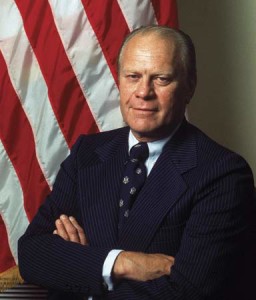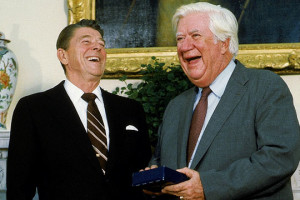Sagebrush Rebellion Revisited – Time to End Federal Control of State Land
on Tuesday, March 22, 2016

Burns, Oregon – January 05, 2016 : Ammon Bundy, the leader of a group calling itself Citizens for Constitutional Freedom which was recently protesting the occupation of State Land by the Federal Government is now in jail in Portland Oregon. Here he speaks to members of the media from the Malheur National Wildlife Refuge. (Photo by Justin Sullivan/Getty Images)
Time to End Federal Control of State Land
By Scott Rohter, February 2016
It is not by coincidence that Article IV Section 3 of the United States Constitution reads as follows: “CONGRESS SHALL HAVE THE POWER TO DISPOSE OF TERRITORY BELONGING TO THE UNITED STATES.” It then goes on to say that “Congress shall have the power to make all needful rules and regulations regarding this property.”
Disposal of land acquired by the Federal Government is the first thing mentioned and the principle objective of the Property Clause.
Congress does not have the Constitutional authority to retain control of 700 million acres of land in twelve Western States for what has been in some cases more than a hundred years after they were admitted to the Union.
The solution to this gross violation of the Equal Footing Principle is clearly to turn over all land acquired by the Federal Government since 1850 to the twelve States from which it was taken through various Enabling Acts.
Public land must be returned to State and local control and the Federal Land Policy Management Act of 1976 should be repealed
It must be done in a manner consistent with the Constitution as well as all applicable State and local land use laws.

President Ford signed the Federal Land Policy Management Act into law.
In 1976 Congress passed the Federal Land Policy Management Act. This legislation formally repealed the Homestead Act of 1862 and put into practice the government’s current policy of retaining control over all public land. Since then the Federal government has not issued any more land grants. The FLPMA was signed into law by President Gerald Ford during his last year in office, but it was proposed and drawn up during the Johnson and Nixon Administrations. It delegated authority to administer public land to the Bureau of Land Management which had been created just thirty years earlier in 1946 by the merger of two completely different governmental agencies who were often at odds with each other.
The General Land Office and the U.S. Grazing Service were frequently at loggerheads over how to manage federal land so after they were merged to form the Bureau of Land Management Congress established the Public Land Law Review Commission in 1964 to come up with a general consensus on what to do with all of the public land that Congress had amassed since 1850.
In its report which was submitted to Congress in 1970 the Public Land Law Review Commission proposed a radically new policy for managing public land. It was a total break from the past. The Commission supported the idea of retaining control over all remaining public lands instead of disposing of them as the government is required to do under the Constitution. In its report to Congress the Commission stated, “We … recommend that the policy of large-scale disposal of public lands reflected by the majority of statutes in force today be revised, and that future disposal should be of only those lands that will achieve maximum benefit for the general public in non-Federal ownership, while retaining in Federal ownership those lands whose values must be preserved so that they can be used and enjoyed by all Americans.” While such language might sound good to some, in reality the Federal Government has no Constitutional authority to own vast amounts of State land no matter how high and lofty the language may sound. The Constitution is quite explicit about how much State land the government can own, how it has to be acquired, and for what purposes it can be used. The Commission proposed a radically different method of administering public land which was just as permanent as it is unconstitutional. The recommendation of the Public Land Law Review Commission in 1970 prepared the way for the passage of the Federal Land Policy Management Act of 1976 which then codified into law the government’s new policy of retaining control over all public land.

President Reagan and House SpeakerTip O’neill
Three years later in 1979 six Western States joined forces to demand the return of all federally administered lands within their borders… Arizona, Nevada, Utah, New Mexico, Washington and Wyoming either passed legislation or filed lawsuits against the Federal government in an effort to wrest control of State land from the Bureau of Land Management and the United States Forest Service.. Their decision to challenge Federal control over vast amounts of State land was called the Sagebrush Rebellion.
The legal challenge presented by the six Western States had no impact at all on the administration of public land during the Carter Administration, but in 1979 Presidential candidate Ronald Reagan indicated that he was sympathetic to their goals. After his inauguration in 1980 President Reagan tried to facilitate a transfer of public land to State control, but his efforts were blocked by a Democrat controlled Congress led by Speaker of the House, Tip O’neill. The Speaker was more concerned about the legal threats emanating from the environmentalist lobby and about a very nasty reduction in contributions to the DNC if he were to go along with the President than he was about implementing the policy goals of the Reagan Administration The only thing that President Reagan could do was to relax of some of the most onerous rules of the Bureau of Land Management through the use of executive order.
The Constitution clearly states in Article 4 Section 3 Clause 2 that Congress shall have the power to dispose of “territory or other property belonging to the United States”. Except for precisely 100 square miles of land composing the District of Columbia (Article I Section 8 Clause 17) that is exactly what Congress is supposed to do. It is supposed to dispose of all other property that it acquires unless it is necessary to build forts, or ports, or post offices, or “other needful buildings”. The power to dispose of land and property does not rest in the White House. It resides in the Halls of Congress, and members of Congress shall have the power to make all of the laws and regulations which are necessary to administer this property until such time as it is disposed of, but make no mistake about it… This land must be disposed of. Congress is not allowed to delay the inevitable disposition of this land indefinitely. It may not retain control of 700 million acres of State land in perpetuity. Congress is only allowed to manage public land until such time as it is properly disposed of.
Every year we see what happens when Congress manages too much public land. Much of it burns to the ground every summer during fire season. The only solution to Congressional mis-management of public land is to turn the land over to State control. Only so much Congressional management of public land that can fit through the rather vague parameters of the General Welfare Clause or the extremely strict criteria of the Property Clause and the Enclave Clause.
There is no Constitutional authority for the United States Government to retain control over fifty percent of the land in twelve Western States. The Property Clause states that Congress has the power to dispose of the land, not the power to control it forever like it is doing under the Federal Land Policy Management Act of 1976.

Lyndon Baines Johnson under whose Administration the unconstitutional Federal Land Policy Management Act was written.
The disturbing legacy of the Public Land Law Review Commission and the Federal Land Policy Management Act is a cause of so much concern not only because it is unconstitutional but because so much of our precious resources are just going up in smoke every year because of federal mismanagement. The problem of what to do with these lands is the subject of a growing national debate as we saw recently in Oregon during the occupation of the Malheur National Wildlife Refuge and in Nevada at the Bunkerville Standoff Trial.
Twenty-five percent of all the land in the United States, and nearly fifty percent of the land west of the Rocky Mountains is controlled by Congress. Ninety percent of the State of Nevada… almost seventy percent of the State of Alaska… It is all administered by just two Congressional agencies. Property rights, grazing rights, and water rights which date all the way back to before the Bureau of Land Management was even created are being invalidated and ignored. Ranchers are being forced to go out of business. Some are being prosecuted and thrown in jail. One rancher who refused to sign his BLM grazing contracts was even shot to death by law enforcement officers for believing that the Federal government should follow the Constitution. It is time to return State land to State control. Its time to correct the historic injustice that was perpetrated on the last twelve States to join the Union.

Oregon rancher Dwight Hammond whose re-incaraceration under an obscure federal anti-terrorism act sparked a firestorm of protest.
As a result of the occupation of the Malheur National Wildlife Refuge it is only proper that Oregon play a leading role in this effort to wrest control of State land from the Federal government. Afterall fifty percent of Oregon is controlled by Congress. What possible reason would the State of Oregon have for not wanting to assert its own sovereignty over its own land? Some say that Oregon does not want to be responsible for fighting fires on public land. If that is true then let me say that the Oregon Department of Forestry could always let our forests burn to the ground just like the United States Forest Service did in 2003 and again in 2017. At least what is left after the fires are out would belong to the people of Oregon. The unconstitutional occupation and administration of 50% of Oregon by the Federal Government must come to an end and it must come to an end in eleven other Western States too.

Arizona rancher Robert Lavoy Finicum was shot three times in the back for challenging the Federal Government’s authority to occupy State land.
THIS IS A LINK TO A NATIONAL PETITION TO RETURN CONTROL OF FEDERAL LAND ADMINISTERED BY THE BLM TO THE STATES AND COUNTIES RESPECTIVELY OR TO THE PEOPLE. PLEASE SIGN IT AND SHARE IT. YOUR NAME WILL NOT BE PLACED ON A MAILING LIST. http://www.ipetitions.com/petition/congressional-petition-regarding-federal-lands
Half of the land in Oregon is controlled by the Federal Government. If you live in Oregon and you would like to see the control of Federal land returned to Oregon Counties and to its people please sign this petition here at http://www.ipetitions.com/petition/oregons-federally-administered-lands
Additional Reading
http://www.hcn.org/articles/utah-bill-would-push-land-transfer-debate-to-federal-court
https://en.wikipedia.org/wiki/Sagebrush_Rebellion
http://www.foresthistory.org/Publications/Books/Origins_National_Forests/sec13.htm

